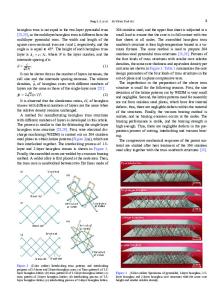Creep expansion of porous Ti-6Al-4V sandwich structures
- PDF / 5,098,554 Bytes
- 13 Pages / 612 x 792 pts (letter) Page_size
- 14 Downloads / 358 Views
I. INTRODUCTION
STRUCTURALLY efficient sandwich panel structures are attracting renewed interest with the emergence of ultralight foamed or highly porous metals.[1] Numerous solid, liquid, and vapor phase processes are being developed for the manufacture of light alloy foams[2–5] and highly porous alloys.[6–11] By bonding these low-density materials between stiff, dense face sheets, light-weight structurally efficient sandwich structures can be developed to replace costly honeycomb structures. When stiff ultralow relative density cores (2 to 5 pct of theoretical density) are used, recent calculations indicate that these structures can be more structurally efficient than semimonocoque, stringer-stiffened plates and shells.[12] However, titanium panels, with porous core relative densities of 0.5 or more, are also attracting interest for the shaped wingskins of aircraft. Here, we experimentally explore a powder metallurgy technique first proposed by Kearns et al.[8,9] and Martin et al.[10,11] for the production of Ti-6Al-4V porous cored sandwich structures. Figure 1 schematically illustrates how these low-density core (LDC) sandwich structures are produced. The process begins with the filling of a thick-walled Ti-6Al-4V canister with Ti-6Al-4V powder and back-filling with between 1 and 7 atmospheres of argon gas. The canister is then sealed and consolidated by hot isostatic pressing DOUGLAS T. QUEHEILLALT, Graduate Assistant, and HAYDN N.G. WADLEY, Associate Dean for Research and Research Professor in Materials Science, are with the Intelligent Processing of Materials Laboratory, Materials Science Department, University of Virginia, Charlottesville, VA 22903. BILL W. CHOI, formerly Research Associate with the Intelligent Processing of Materials Laboratory, Materials Science Department, University of Virginia, is Postdoctoral Research Staff Member, Lawrence Livermore National Laboratory, Livermore, CA 94551. DANIEL S. SCHWARTZ, Engineer, is with The Boeing Company, St. Louis, MO 63166. Manuscript submitted March 15, 1999. METALLURGICAL AND MATERIALS TRANSACTIONS A
(“HIPing”) to create a 95 to 98 pct dense material with gas-filled porosity. These consolidated samples are then hot rolled to create a plate consisting of a core with a finely dispersed pore distribution. The structure contains pores with high internal pressures and thin, fully dense face sheets (inherited from the original canister). The small pores are then re-expanded using a high-temperature annealing step. This process results in a low-density cored sandwich structure with the core containing 35 to more than 50 pct porosity. The mechanical performance of the panel is governed by the core’s relative density and elastic properties and the face sheet’s thickness and, therefore, are dependent on the degree of expansion of the porous core.[13,14] Little is quantitatively known about the rate of pore expansion, its dependence upon initial pore pressure, the effect of expansion temperature, the change in pore shape that accompanies expansion, the relationship
Data Loading...











